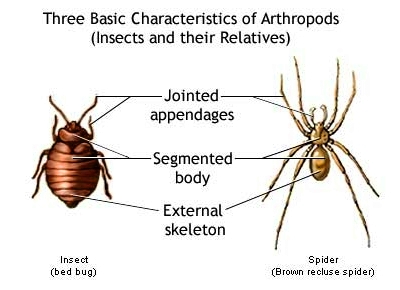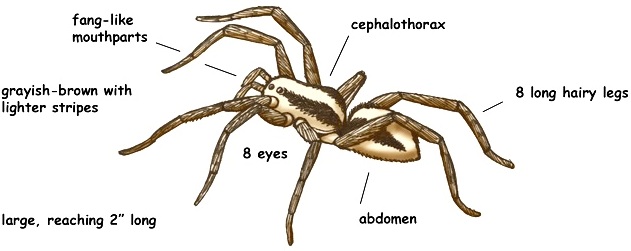Phylum - Annelida and Arthropoda
Table of Content |
|
|
Phylum-Annelida
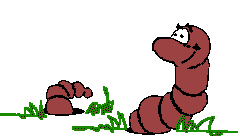
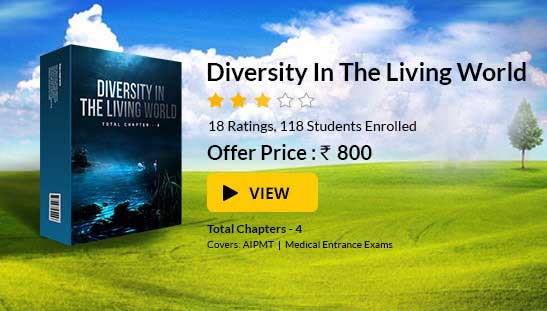 - Bilateral and protostomial eucoelomate eumetazoans whose long, narrow and worm like body is divided into ring-like, true or metameric segments (Gr., annelus = little ring), and the skin usually bears unjointed, chitinous appendages, termed setae.
- Bilateral and protostomial eucoelomate eumetazoans whose long, narrow and worm like body is divided into ring-like, true or metameric segments (Gr., annelus = little ring), and the skin usually bears unjointed, chitinous appendages, termed setae.
- Commonly known as “segmented worms”.
- About 9,000 species known.
Brief History
Linnaeus (1758) included all soft–bodied worms in “Vermes”. Lamarck (1801) established phylum annelida for higher types of worms.
Salient Features
(1) Annelids are bilaterally symmetrical animals 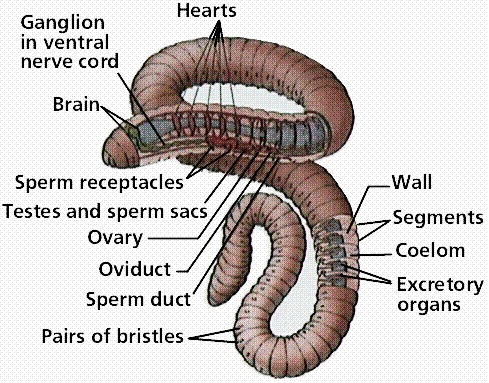
(2) They have organ-system grade of organization
(3) They are coelomate animals
(4) They have triploblastic body wall
(5) The muscle layers are thick in the body wall. Hence the body wall is said to be dermomuscular
(6) The body is divided into a numerous segments called the metameres. The segmentation is known as metamerism
(7) The body is covered with a thin cuticle.
(8) Locomotory organs are setae.
(9) Digestive system is well developed
(10) Blood vascular system is a closed type
(11) Excretory system is formed of segmentally arranged nephridia.
(12) Nervous system is formed of a pair of cerebral ganglia (brain) and a double ventral nerve cord
(13) Mostly annelids are hermaphrodites
(14) The gonoducts are formed from coelom (coelomoducts). The coelomoducts have connection with nephridis.
(15) Regeneration is common character in this phylum
(16) Their development is direct or indirect.
Classification of Annelida
Class 1. Polychaeta
(1) Polychaeta are marine and carnivorous.
(2) Body is elongated and segmented.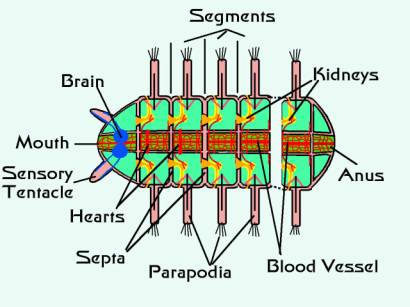
(3) Head consists of prostomium and peristomium and bear eyes, tentacles, cirri and palps, etc.
(4) Setae are numerous and are borne up on lateral prominances of the body wall known as parapodia
(5) Clitellum is absent
(6) Cirri or branchiae or both may be present for respiration
(7) Coelom is spacious usually divided by inter segmented septa
(8) Alimentary canal is provided with an eversible buccal region and protrusible pharynx.
(9) Excretory organs are segmentally paired nephridia
(10) Saxes are separate
(11) Fertilization is external; free swimming larval stage is trochophore
(12) Asexual reproduction occurs by budding.
(13) Examples : Nereis, Aphrodite, Polynae, Chaetopterus
|
|
Class 2. Oligochaeta
(1) They are mostly terrestrial or some fresh water forms.
(2) Body has conspicuous external and internal segmentation.
(3) Dsitinct head, eyes and tentacles are absent.
(4) Parapodia are absent.
(5) Setae are usually arranged segmentally.
(6) Clitellum is usually present.
(7) Pharynx is not eversible and without jaws.
(8) They are hermaphrodites.
(9) Development is direct and takes place within cocoons secreted by clitellum.
(10) No free larval stage
(11) Examples : Tubifer, Pheretima, (All earthworms).
Class 3. Hirudinea
(1) This class includes mostly ectoparasitic and fresh water forms, while few are marine, feeding upon fishes and other animals.
(2) Body is elongated usually flattened dorso–ventrally or cylindrical
(3) Body consists or definite number of segments, each segments breaks up into 2 to 4 rings or annuli
(4) Parapodia and setae are absent
(5) Body is provided with an anterior and a posterior sucker, both situated ventrally
(6) Mouth opens on the ventral surface in the anterior sucker, while anus opens dorsal to the posterior sucker
(7) Hermaphrodite i.e., sexes united
(8) Reproduction sexual. Asexual reproduction is not known
(9) Eggs are usually laid in cocoons.
(10) Development is direct without free swimming larval stage
(11) Examples : Acantaobdella, Glossiphonia (All leeches)
Class 4. Archiannelida
(1) They are exclusively marine forms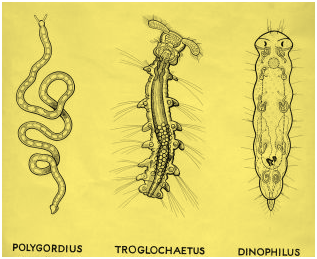
(2) Body elongated and worm-like
(3) Setae and parapodia are usually absent
(4) External segmentation is slightly marked by faint while internal segmentation is marked by coelomic septa
(5) Prostomium bears two or three tentacles
(6) Unisexual or hermaphrodite
(7) Larva is typical trochopore
(8) Examples : Polygoridus, Protodrillus, Nerilla, Saccocirrus, etc.
Phylum-Arthropoda
 - Bilateral and protostomial eucoelomate eumetazoa with metamerically segmented body and each segment bearing a pair of jointed locomotory appendages.
- Bilateral and protostomial eucoelomate eumetazoa with metamerically segmented body and each segment bearing a pair of jointed locomotory appendages.
- “Arthopoda” literally means animals bearing jointed feet (Gr., arthron = jointed + podos = foot).
- These are extremely successful animals due to a protective exoskeleton and jointed appendages.
- That is why, more than 8 and half lac arthropod species are known as against about 2 and half lac species of the remaining animals.
Brief History
Aristotle described a few crabs and other arthropods. Linnaeus included all such animals in his group “Insecta”. Lamarck divided this group into three classes – Crustacea, Hexapoda and Archnida. Finally, Vonsaibold (1845) established the phylum Arthropoda for these animals.
Salient Features
(1) Occur widely on land, in air, and in all sorts of water, form snowy tops of high mountains to the depths of ocean. Many are parasites of other animals and plants. Hence, the phylum is of great economic importance.
(2) Bilateral, triploblastic body segmented and also divided into head, thorax and abdomen. Segmentation marked only externally; number of segments or somites fixed and each has its separate exoskeleton of thick and hard, chitinous cuticle secreted by epidermis of body wall. Head somites always fused.
(3) Each segment basically bears a pair of lateral jointed appendages adapted for food ingestion, locomotion, respiration, copulation, etc.
(4) Muscular system well-developed; muscle fibres always striated.
(5) Digestive tract complete. Most head appendages from mouth parts with lateral jaws for chewing or sucking. Anus terminal
(6) Coelom reduced to small cavities in excretory and reproductive organs; replaced elsewhere by blood sinuses which merge together to form a large perivisceral cavity – the haemocoel–around viscera. Sinuses form an “open blood vascular system” filled with haemolymph which may contain haemocyanin. Haemocoel communicates with a long tubular and pulsatile, mid–dorsal heart.
(7) Respiration by gills (aquatic forms), or tracheae or book lungs (terrestrial forms); by diffusion through body surface in some
(8) Excretion by coelomoducts or specialized green or coxal glands, or by malpighian tubules
(9) Nervous system basically similar to the typical annelid plan; head with a brain-ring which is connected to a double ventral nerve cord, having paired segmental ganglia which represent true metamerism. Well–developed sensory organs of various types.
(10) Sexes mostly separate with sexual dimorphism
(11) Fertilization typically internal, in female's body. Eggs megalecithal. Oviparous or viviparous
(12) Life–cycle includes one or more larval stages that metamorphose into adults.
Classification of Arthropoda
On basis of body shape, degree of segmentation and regionation, and presence or absence of certain appendages (antennae, mandibles and chelicerae), phylum Arthropods is divided into three subphyla.
Sub-phylum Trilobita
(1) Most primitive, extinct, marine arthropods of Cambrian to Permian rocks.
(2) 10 to 675 mm. Long body covered by a hard segmented shell; distinct head of four fused somites bearing a pair of antennae, four pairs of appendages and often a pair of eyes.
(3) Trunk divided, by two longitudinal furrows, into 3 lobes.
(4) Abdominal region of 2 to 29 somites and a fused caudal plate or pygidium.
(5) Each segment, except the last one, bears a pair of biramous jointed appendages.
(6) Example – Triarthrus.
Sub-phylum Chelicerata
 (1) Mostly terrestrial, free–living and small–sized.
(1) Mostly terrestrial, free–living and small–sized.
(2) Body distinguished into head, thorax and abdomen (= opisthosoma). Head and thorax fused to form a cephalothorax or prosoma.
(3) Cephalothorax with eyes and six pairs of appendages – One pair of clawed and jointed chelicerae in place of mandibles, one pair of pedipalps, and four pairs of walking legs. Antennae absent. Abdomen with or without appendages, but distinguished into a large and broader mesosoma, a small metasoma and a long and narrow, tail–like telson.
(4) Respiration by gills book–lungs or tracheae.
(5) Excretion by malpighian tubules or coxal glands, or both.
(6) Sexes mostly separate; females oviparous; development direct or through a larval stage. Divided into three classes on the basis of respiratory organs
Class (1) – Merostoma
(1) They are Marine.
(2) Respiration by gills.
(3) Cephalothroax with lateral compound eyes and six pairs of usual appendages.
(4) Abdomen with 5 to 6 pairs of gill–bearing appendages.
(5) Hind end forms a long bayonet–like telson.
(6) Example– Limulus (The king-crab). Limulus is a living fossil.
Class (2) – Arachnida
(1) Mostly terrestrial; spiders, scorpions, mites, ticks, etc.
(2) Respiration by book–lungs of tracheae.
(3) Eyes simple
(4) Abdomen without appendages.
(5) Many with poison glands and poison fangs, jaws of stings.
(6) No gills.
(7) Life–cycle without metamorphosis.
(8) Examples – Palamnaeus (scorpion), Lycosa (the common web–spinning spider; web–spinning glands are situated in posterior part of abdomen). Spiders and scorpions are includes in class Arachnida.
Class (3) – Pycnogonida or Pentapoda
(1) Small–sized marine sea–spiders.
(2) Cephalothorax 3–segmented; forms major part of body; abdomen vestigial.
(3) Suctorial mouth on top of a long proboscis.
(4) Head usually with 4 pairs of appendages and 4 eyes.
(5) 5, 6 or 12 pairs of long walking legs.
(6) No special respiratory and excretory organs.
(7) Unisexual; females oviparous. Eggs carried by males.
(8) Example – Nymphon.
Sub-phylum Mandibulata or Antennata
(1) Body divided into head and trunk, or head, thorax and abdomen.
(2) Segmentation distinct.
(3) 1 or 2 pairs of antennae, 1 pair of mandibles in place of chelicerae, one or more pairs of maxillae and 3 or more pairs of walking legs.
(4) Eyes mostly compound.
(5) Respiration by gills or tracheae.
(6) Excretion by malpighian tubules or antennal glands.
(7) Unisexual; life cycle usually with larval forms. Divided into six classes
Class (1) – Crustacea
(1) Mostly aquatic.
(2) Body divided into cephalothroax and abdomen.
(3) Dorsally, cephalothorax covered by a thick exoskeletal carapace.
(4) Head of 5 segments, with 2 pairs of antennae, one pair of mandibles and 2 pairs of maxillae; thorax of 2 to 60 distinct or variously fused somites; abdominal somites usually distinct with a posterior telson.
(5) Appendages mostly biramous.
(6) Respiration through body surface or by gills.
(7) Excretion by special coxal glands in antennae or maxillae.
(8) Mostly unisexual; genital ducts and pores paired; females oviparous.
(9) Life-cycle usually with larval forms.
(10) Examples –Palaemon (prawn), Cancer(Crab) , Cyclops (Water-flea), Crayfish.
Class (2) – Insecta
(1) Aquatic, terrestrial or aerial.
(2) Body divided into head, thorax and abdomen.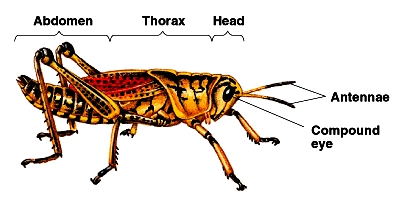
(3) Segments 6 in head, 3 in thorax and 11 or less in abdomen.
(4) Legs typically 3 pairs (Hexapoda); aerial forms with one or two pairs of wings.
(5) Head with 1 pair of large, compound eyes, 1 pair of antennae and variously modified mouth–parts.
(6) Respiration by branched tracheae.
(7) Excretion by specialized malpighian tubules.
(8) Unisexual; females oviparous.
(9) Life-cycle simple or complicated.
(10) Examples – periplaneta (Cockroach), Musca (house-fly), Mosquitoes, locusts butterflies, bees, wasps, termites, silverfish (Lepisma), beetles, etc. Insects are of great economic importance to mankind. Silverfish is not a fish.
Class (3) – Diplopoda (Millipedes)
(1) Terrestrial.
(2) Body long, cylindrical, worm–like.
(3) 5-segmented head with 1 pair each of short antennae, mandibles and maxillae; 2 groups of simple eyes.
(4) Thorax of 4 segments, each except the first with a pair of joined legs.
(5) Abdomen of 9 to 100 or more segments, but each apparent segment formed by fusion of two and, hence, bears 2 pairs of legs, spiracles, ostia and nerve ganglia.
(6) Respiration by tracheae.
(7) Excretion by malpighian tubules.
(8) Unisexual; gonad single; females oviparous.
(9) Example – Thyroglutus (millipede)
Class (4) – Chilopods (Centipedes)
(1) Terrestrial.
(2) Body long, worm–like, somewhat dorso–ventrally flattened and divided into head and trunk. 
(3) Segments 15 to 181; not fused in pairs; each with a single pair of legs; first pair of legs claw like and each contains a poison gland.
(4) Head with a air each of long antennae and mandibles, and 2 pairs of maxillae.
(5) Respiration by tracheae.
(6) Unisexual; females oviparous or viviparous. Genital openings mid ventral on last but one segment.
(7) Excretion by malpighian tubules.
(8) Example – Scolopendra (centipede).
Class (5) – Symphyla
(1) Terrestrial.
(2) Body upto 6 mm. Long; divided into head and trunk.
(3) Head like that of insects, but without eyes.
(4) Trunk of 15 to 22 somites; bears 10 to 12 pairs of legs.
(5) Genital pores mid ventral between legs of 4th pair.
(7) Example – Scutigerella (the garden centipede).
Class (6) – Pauropoda
(1) Terrestrial.
(2) Minute, soft and cylindrical, worm like body divisible into head and trunk.
(3) Head with one pair each of branched antennae and unbranched mandibles and maxillae; no eyes.
(4) Trunk of 11 or 12 somites which are dorsally fused in pairs.
(5) Legs 9 to 10 pairs.
(6) Genital pores ventral on 3rd trunk segment.
(7) Example – Pauropus.


Question 1: Metamerically segmented body is present in
(a) Earthworm
(b) Leech
(c) Nereis
(d) All of the above
Question 2: Earhworm is placed in the group
(a) Oligochaeta
(b) Polychaeta
(c) Hirudinea
(d) Crustacea
Question 3: Chloragogen cells of earthworm are similar to the organ of vertebrate’s
(a) Liver
(b) Lung
(c) Kidney
(d) Spleen
Question 4: Male genital aperture of earthworms is located in the segment
(a) 13
(b) 14
(c) 19
(d) 18
Question 5: Annelids are
(a) Radially symmetrical
(b) Externally segmented
(c) Triploblastic
(d) Pseudocoelomate
Question 6: Book lung is the character of
(a) Mollusca
(b) Insect
(c) Arachnida
(d) Crustacea
Question 7: Cephalothorax is found in the
(a) Arthropoda
(b) Annelida
(c) Nematoda
(d) Echinodermata
Question 8: Presence of hepatopancreas is character of
(a) Annelida
(b) Echinodermata only
(c) Arthropods only
(d) (b) and (c)both
Question 9: The process of conversion of a small cockroach into an adult cockroach is called as
(a) Moulting
(b) Metamorphosis
(c) Ecdysis
(d) Transformation
Question 10: 'Hexapoda' is another name of
(a) Crustacea
(b) Arachnida
(c) Insecta
(d) Archiannelida
| Q.1 | Q.2 | Q.3 | Q.4 | Q.5 |
| d | a | a | d | c |
| Q.6 | Q.7 | Q.8 | Q.9 | Q.10 |
| c | a | c | b | c |
Related Resources
-
Click here to refer the Useful Books of Biology for NEET (AIPMT)
-
Click here for study material on Anatomy of Flowering Plants
To read more, Buy study materials of Animal Kingdom comprising study notes, revision notes, video lectures, previous year solved questions etc. Also browse for more study materials on Biology here.
View courses by askIITians


Design classes One-on-One in your own way with Top IITians/Medical Professionals
Click Here Know More

Complete Self Study Package designed by Industry Leading Experts
Click Here Know More

Live 1-1 coding classes to unleash the Creator in your Child
Click Here Know More



